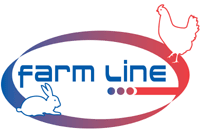

| Sponsors partenaires du MCF, informations et conditions par mail : CONTACT | |||||||
 |
|
 |
|||||
Photos sous licence Creative Commons
type http://creativecommons.org/licenses/by-sa/3.0/deed.fr
CC by sa
|
The silver-cuckoo variety |
|
|
|
The cuckoo variety (as the same-named bird) is not only the prerogative of our Marans breed. Others breeds are well-known for being typical of this plumage color notably the "Malines-cuckoo" or the "Rennes-cuckoo" and many others... |
The cuckoo plumage is due to the (B) gene which is a dominating and linked to sex characteristic.
Genetically speaking, it is impossible to obtain for the silver-cuckoo subjects a very good clearness of the stripped drawings of the pllumage. It is usual to obtain an irregular or quite coarse blocking on the whole feathers.
In this way, the Marans standard has justly no specific requirements concerning the cuckoo plumage darkness. It is very logically coherent in the color description. On the other hand, the cock plumage is defined to be lighter than the hen plumage which is genetically altogether logic.
Why do the cocks are light colored and the hens dark-colored ?
| We have to get it into our
head that the cuckoo poultries are in a way black
subjects (E/E base) or perhaps Brown-red (ER/ER base) in
the Marans whose genotype is completed by a genetic
dominating (B) factor, the "cuckoo gene" which
replaces the black plumage by the cuckoo drawing of a
little bit rough nature that we know for some breeds such
as the Marans.
Another dominating (S) gene, called "silver" cames to intensify the silver white color in the plumage of the hackle, back, shoulders, lancets. We must remember a fundamental element (which we once remained misunderstood by some farmers) ,i.e that the cuckoo color |
|
In this way, the cuckoo (B)
color factor expressed itself on each of the two (B/B)
chromosomes present in the cock. As it is doubly
expressed this cuckoo characteristic give then a lighter
shade to the cock feathers. It is also intensified in
them by the presence of the (S) silver characteristic
which in it, lightens not only the hackle but also the
back, the shoulders and the lancets.
On the other hand, concerning the cuckoo hens, the (B) factor applying on only one allele, the second remaining unexpressed, the hen plumage can only be dark-cuckoo (B/b) instead of (B/B). |
| is due to a factor called "linked to sex" as there are many in the genetics of our poultries, pigeons, and rabbits.It means that the concerned color genes are not worn in the same by the male and by the female. How could we require in these conditions an identical color for the two sexs ? (cf the Rennes-cuckoo) |
Photos sous licence Creative Commons
type http://creativecommons.org/licenses/by-sa/3.0/deed.fr
CC by sa
It is normal that in the Silver-Cuckoo (and even in the Golden-Cuckoo) selection, the cocks are lighter than the hens and we have at least three good reasons to require that :
- they are nicer in
this way (there's no account for tastes...!)
- they are autosexable and the differentation must always remain
sufficiently clear between the cocks and the hens. It is a
supplementary appeal.
- they are genetically coherent because it's rally the light
cocks and not the others which are the pure subjects for the
"Cuckoo factor" (it is still the case for the other
stripped factor but which concerns others breeds).
It is logical to select according to your personnal taste Cuckoo founders which are darker or lighter than the usual color and even with the clearer and more contrasted drawing of the stripped bvs such as the "Plimouth Rock" and which have nothing to do with them. There is one and only one "natural Cuckoo" shade corresponding to the Cuckoo variety, apart from a slight shade.
The Silver-Cuckoo variety must be able to be revived at any time by Plain-Black variety (as long as it still exists at the pure state) or by the Silver-Black which is extremely linkd to it. The opposite is as well true. In this respect, we can notice that nature imposes little by little his laws. There are definetely "Black Malines", a "La Flèche Cuckoo" , a "Hollandaise Cuckoo"…
Slowly, we begin to notice the appearence of the varieties that the genetics favor in a logical and natural way.
Finally, and because everything in the logic holds together when we regenerate a Cuckoo stock, which was selected too light, by crossing it with a black subject (E or ER family), nature will always tend to restor the normal cuckoo color… and it is allright in this way !
In comparison with the whole body, the cuckoo plumage tonality for the hackle and the lancets of the cocks, getting closer rather to white (or "silver-white"). The cock plumage is so in a way as a cuckoo fenery.
As for the hens,
the plumage is more uniform and very dark as a rule, allowing to
respect or refflect their autosexable subject genetic
characteristics.
A slightly lighter shade must be recognized for the hen hackles
and we can tolerate a more or less darker shade of the whole if
this shade doesn't wander too much from the standard shade.
The deliberate selection of founders which are turned towards lighter silver-cuckoo must be avoided vecause it goes against nature and it is "off-standard".
The great color flaw concerning the Silver-Cuckoo is essentially the appaearence of fawn colored (or coppery) feathers about which it would be proper to be rigorous.
They appear, as the fawn colored feathers, more rarely in the Cuckoo plumage because we are faced with a color which is pretty less capricious than others (as the Brown-red Marans or even fawn with a black tail color) to be set.
See also the Marans official standard: silver-cuckoo color.
THE OFFICIAL VARIETIES OF THE CURRENT STANDARD
|
Silver-cuckoo Variety |
|
OTHER VARIETIES NOT APPROVED YET